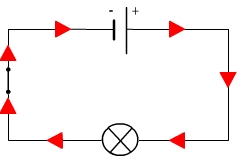
Electricity
Learning physics
and chemistry
easily and freely - Science for elementary school, middle school and
high school
Free online electricity lessons for elementary school, middle school and high school.
The electric current
Direction of electric current in a circuit
1) Conventional direction of electric current
Outside a battery or an electric generator, the electric current flows from the negative to the positive terminal.
2) La représentation du sens du courant sur un schéma
The current direction can be indicated in a circuit diagram by placing a red arrow on one side.
Example:

Comment: We may indicate the direction of current only in a circuit where the electric current really flows. For example The direction of current must not be indicated in a circuit with an open switch.
3) Influence of current direction on passive components
Some passive components have a different functioning if the direction of electric current is reversed: these components are polarized.
For instance electric motors are polarized:If the current direction is reversed then they rotate in the opposite direction.
In the opposite case we speak of non-polarized components.
Connection wires, bulbs, switches are not polarized and therefore can be connected in any sense.
Comment: the direction of current flowing through a component can be reversed by reversing connections of the battery or by reversing connections of component.

| Science class |
Chemistry Electricity Optics Mechanics |
| Electricity lessons |
| Electrical
components -Two-terminal electronic components - Basic electrical components - Diodes - What's a resistor ? - How to determine a resistor value ? - Resistors effects in circuits - How to use a resistor ? - Characteristic curve of a resistor How to build simple circuits and draw diagrams - How to build a basic electrical circuit - How to draw diagrams of electric circuits The electric current - Conductors and insulators - Direction of electric current in a circuit - The dangers of electricity - Current intensity - units how to measure current ? The Voltage - The voltage and its units - How to measure a voltage ? - Voltage in open and closed circuits - Rated current and voltage for a lamp Alternating voltage and current - Alternating currents effects on led - What are alternating current and voltage ? - Periodic alternating voltage and its properties - Oscilloscope - Oscillogram - Frequency - Measuring RMS voltage with a voltmeter Serie circuits - What's a serie circuit ? - Series circuit properties - Short circuit in series circuit - Current law in series - circuits - Voltage law in series circuits Parallel circuits - What's a parallel circuit ? - Some parallel circuits properties - Short circuits in parallel circuits - Nodes and branches in parallel circuits - Current laws in parallel circuits - Voltage laws in parallel circuits Laws of electricity - Ohm's law - Current laws in series circuits - Voltage laws in series circuits - Current laws in parallel circuits - Voltage laws in parallel circuits Generating electricity - Voltage for coil wires What is an alternator ? - Alternating currents and voltages - Generating electricity in power plants Electric power and energy - Electric power and power rating - Electric power received by an electrical device - Electric power consumption by an electrical device - Relationship between - Electric power and energy |
|
|
©2021 Physics and chemistry


